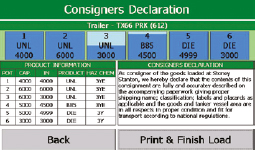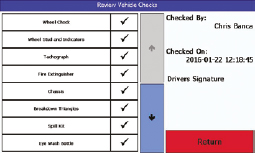Today’s oil & gas distributors face a minefield of documentation relating to the International Carriage of Dangerous Goods by Road (ADR) legislation, as well as local safety legislation and tax compliance rules. This guide gives a brief overview of documentation requirements necessary to comply with UK HMRC rules. The good news is that TouchStar Technologies have many decades of experience in understanding & interpreting legal documentation and developing IT solutions that assist operator compliance. Our FuelStar and GasStar software runs on our ATEX-approved in-vehicle computers to capture the real time data that is important to each operator. Our systems can handle ANY type of delivery scenario including bulk fuel, retail petroleum, home heating, on-site fleet & aircraft fueling... with legal documentation compliance assured in every instance.
1. WHY DO I NEED DOCUMENTATION?
Because it is required by Law. In practice most companies have been using delivery and loading tickets for years and may be complying with this Order already, although the idea of carriage documents to record transfer of fuel (i.e. non-sale carriage) may be new to some.
2. WHAT IS LIQUID FUEL?
It is Diesel, Gas-Oil, Kerosene, Paraffin and Petrol, but note that different types/grades of Petrol (e.g. 4 star, super unleaded and unleaded) must be treated as different types of fuel and listed separately in any documents. Liquid Petroleum Gas (LPG) is not caught by this Order.
3. WHAT IS A ROAD TANKER?
Any vehicle or trailer constructed to carry liquid fuel or which carries a tank of 3,000 litres (660 gallons) or more. Most road tankers are purpose built, but the Order covers other situations, e.g. a detachable tank carried on a flat bed lorry.
4. WHEN DO I NEED DOCUMENTATION?
When carrying liquid fuel by a road tanker on a journey on a public road.
5. WHAT DOES A ‘JOURNEY’ MEAN?
A journey starts when a road tanker goes onto a public road and ends every time fuel is loaded onto the vehicle. This is important because the person in charge of the vehicle, normally the driver, must be handed the appropriate documents before the start of every journey. If fuel is loaded/uplifted during a run then the loading document will need to be amended or a new one issued.

6. WHAT IS A LOADING DOCUMENT?
This records the types and quantities of fuel loaded at the start of the journey. In addition to listing this information the loading document will need other information such as date, load number, vehicle registration mark, driver, place of loading, delivery ticket numbers.
7. WHAT IS A DELIVERY DOCUMENT?
Whenever fuel is delivered to a buyer, a delivery document must either be given to that buyer or left at some suitable place. There are no exceptions to this rule. A delivery document must have the following information on it:-
(a) the name and address of the seller or his agent;
(b) the name of the buyer and the delivery address;
(c) the date of delivery;
(d) means to identify that delivery with its Loading Document;
(e) the quantity and type of fuel delivered.
8. WHEN DO I HAVE TO PUT THIS INFORMATION ON THE DELIVERY DOCUMENT?
At the latest before the document is handed to the buyer or left at the delivery place, but if any of this information is known before this, then the delivery documents should be made out before the tanker starts its journey.
9. WHAT IS A CARRIAGE DOCUMENT?
Where fuel is being carried without a sale occurring (e.g. transfer between depots) a carriage document is required. This must state:-
a) name and address of the person causing the transfer (not necessarily the haulier);
b) the delivery place;
c) the delivery date;
d) the statement 'Fuel not for Sale' or similar or a list of the types and quantities of fuel which are not for sale.
A Loading Document suitably amended will normally be effective for this purpose.

10. DO I HAVE TO USE SPECIAL FORMS TO COMPLY WITH THE LAW?
No, providing all the information outlined above is given then you can use any forms.
11. ARE THERE ANY SPECIAL REQUIREMENTS FOR TANKERS WITH ‘WET LINE’ METER SYSTEMS?
Yes, on loading and carriage documents you must state the quantity and type of fuel in the system at the start of the journey.
12. WHAT ABOUT USING THE TICKET PRINTER ON MY METER SYSTEM?
If you use the meter system then you must use the ticket printer. Most operators use a meter ticket with all the delivery information on it, but if a separate delivery document is used then it must have a meter printed ticket attached to it.
13. SUMMARY
The documents you need, depending on the type of journey, are:-
Type of Load on Journey
Documentation
Non-sale delivery – to one premises only
a) one carriage document only
Non-sale deliveries –two or more premises
a) separate carriage for each premises
b) may also have loading documents which duplicates all or part of this information
Mixed load of sales and non-sales deliveries
a) loading document
b) delivery document(s)
c) carriage document(s)
Sales deliveries to one or more premises
a) loading document
b) delivery document